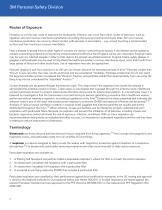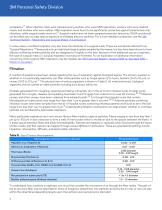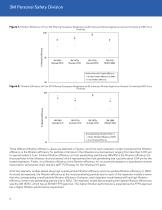
Catalog excerpts

Technical Data Bulletin Release 5, June 2020 #174 Respiratory Protection for Airborne Exposures to Biohazards This is a general document that is not specific to any particular airborne contaminant, including viruses and bacteria, and that is intended for a sophisticated occupational audience. Abstract Diseases can be transmitted via many routes, including inhalation of aerosols. When properly fitted, selected, used, and maintained, particulate-removing respirators have been demonstrated to reduce the amount of aerosols – both bioaerosols and non-biological aerosols – that are inhaled by the wearer. In contrast, most surgical masks are not designed to seal tightly to the face, and research has shown that they do not achieve the level of contaminant reduction provided by a certified respirator that is used correctly. Although questions have been raised as to whether or not biological particles can be filtered as well as non-biological particles, research shows that a respirator filter will remove bioaerosols in a similar manner as it removes non-biological aerosols from air that passes through it. When respiratory protection is needed to help reduce exposure to bioaerosols, the user should select a certified particulate respirator according to recommendations from CDC, WHO or applicable local agencies. Once a respirator has been selected, a continuing, effective respiratory protection program as specified by applicable local regulations must be implemented. This includes training on the respiratory hazards, fit testing, and proper maintenance and disposal of the respirators. Introduction Recently there has been growing interest in the use of respirators to help protect against certain airborne biohazards. Diseases that may be caused by inhalation of airborne biological organisms include tuberculosis (TB), Hantavirus, anthrax, coronaviruses (including SARS, MERS and others), and influenza. Biohazards may become airborne, perhaps as the agent itself, such as an anthrax spore, or as the agent riding on some other material that becomes airborne, such as dusts, mists or droplet nuclei. Hantavirus infection has been caused by people inhaling soil dust that became airborne after rodents shed virus via urine, feces or other materials into the soil. In fact, it is generally thought that airborne viruses are normally attached to other particles and rarely exist as naked organisms.1 Inhalation of these bioaerosols may be reduced by wearing respirators. The US Centers for Disease Control and Prevention (CDC), the World Health Organization (WHO), and national health authorities have made numerous recommendations for respirator use where they believed the potential for the spread of disease through the airborne route exists. Considerations for selection and use of respirators to help reduce exposure to bioaerosols include: • • • • • Filtration Microorganism survival on the filter Potential reaerosolization of the bioaerosol Reuse of the respirator Fit and the assigned protection factor of the respirator These topics are addressed in t
Open the catalog to page 1
3M Personal Safety Division Routes of Exposure Inhalation is not the only route of exposure for biohazards. Infection can occur from other routes of exposure, such as ingestion, skin and mucous membrane penetration (including the eyes) and animal and insect bites. Skin and mucous membrane penetration can occur by direct contact with aerosols or secondarily – e.g., a hand touching a contaminated surface and then touching a mucous membrane. How a disease is spread informs what types of controls are useful in preventing its spread. If the disease can be spread by contact, preventing surfaces...
Open the catalog to page 2
3M™ Product NameDivision 3M Personal Safety Filtration efficiency is one of the performance parameters evaluated for certification. Table A contains some of the minimum filtration efficiency requirements according to US, Europe and China standards. There are many test variables that affect performance such as type of aerosol, particle size, flow rate, whether the aerosol has been charge-neutralized to the Boltzmann equilibrium state, etc. For a more detailed comparison of global filtering facepiece respirator regulations, see the 3M Technical Bulletin - Comparison of FFP2, KN95, and N95 and...
Open the catalog to page 3
3M Personal Safety Division workplaces.17 When infection rates were tracked among workers who wore N95 respirators, workers who wore medical masks, and workers who wore neither, N95 respirators were found to be significantly protective against bacterial and viral infections, while surgical masks were not.17 Surgical masks have not been assigned protection factors by OSHA and should not be relied upon to help reduce exposure to inhalable airborne particles. For a more detailed comparison, see the 3M Technical Bulletin - Respirators and Surgical Masks: A Comparison. In a few cases, a...
Open the catalog to page 4
3M™ Product NameDivision 3M Personal Safety Very large particles (> 100 μm) in slow moving airstreams may settle out due to gravity. However, most respirable particles are too small for this mechanism. Respirable particles above 0.6 μm in diameter are typically captured efficiently by interception and inertial impaction.23 Inertial impaction occurs when a particle cannot follow an air streamline around a fiber because of its inertia and instead impacts into the fiber. In the interception mechanism, the particle holds to the streamline, but that streamline will naturally bring the particle...
Open the catalog to page 5
3M Personal Safety Division Figure 1. Filtration Efficiency of Four 3M Filtering Facepiece Respirators at 85 Liters per Minute Against an Aerosol Containing H1N1 Virus Particles. Figure 2. Filtration Efficiency of Four 3M Filtering Facepiece Respirators at 85 Liters per Minute Against an Aerosol Containing H5N1 Virus Particles Three different filtration efficiency values are depicted in Figures 1 and 2 for each respirator model. Overall particle filtration efficiency is the filtration efficiency for particles of all sizes in the influenza virus test aerosol, ranging from less than 0.010 µm...
Open the catalog to page 6All 3M Health Care catalogs and technical brochures
-
The Importance of Fit
1 Pages
-
Warm Every Surgical Patient
2 Pages
-
OrthodonticProduc
236 Pages
-
Clarity
12 Pages
-
RelyX Ultimate
2 Pages
-
paradigm™
4 Pages











